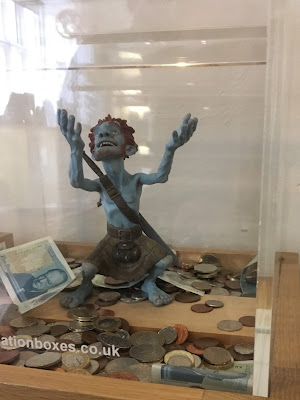When I went to Chichester to see King Lear last weekend, I was able to tale the opportunity to stay with my sister and brother in law, and, as well as lots of catching up and a certain amount of rather nice food, I also paid a flying visit to Portchester Castle.
 |
| Portchester Castle from the shore |
The previous evening had been very stormy (both inside and outside the theatre, for me!) but by Sunday morning the wind had a dropped a bit, and the sun was out.
K and I strolled along the shoreline, and then I took a quick look around the castle (hurrah for English Heritage membership!)
 |
| View from the castle towards Portsmouth |
It has a particularly long history as a fortification - originally, there was a Roman Fort, (and parts of the walls are the original Roman ones) then a Saxon community, then a medieval castle was built in one corner of the original fort. Various Kings of England used the castle as a stopping off point when travelling, Richard II had a set of new Royal apartments built there, and Henry V used it before departing to invade France. (It's probably also where the traitors plotting against him, were executed)
In 1632 Charles I sold the castle (apparently by this time, Portsmouth had become a more important port, so presumably he felt it was less important to keep the castle in Royal hands.
It had rather less glamorous roles after that - it was used as a prison for Dutch prisoners of war in the 1660s, and for French (and French colonial) prisoners during the Napoleonic wars. Inside the castle there was a display about its use as a prison, including information about around 2,000 black and mixed race prisoners from the Caribbean (the French Revolutionary government declared the abolition of slavery in 1794, and recruited large numbers of former slaves into their armed forces, many of whom were then taken prisoner when the French garrison on St Lucia surrendered to the British, (the French having negotiated to ensure that these soldiers would be treated as prisoners of war, and not as slaves)
They ended up in Portchester Castle, although they were later moved to prison ships in the harbour, partly to protect them from the European prisoners kept in the castle, who were in the habit of stealing the warmer clothes provided to them.
Very interesting, and according to the information, it was common practice for the Navy to actively recruit prisoners of war, so it's quite likely that some of these men ended up serving in the British Navy.
There were several pieces of art on display - I particularly enjoyed this ship, on the crest of a wave formed from one corner of a chart, showing (a little depressingly) British Prisoner of War 'depots' across the war during the later 18th C.
It would have been interesting to spend a little longer there, but we had Sunday Lunch to cook, so I didn't. Maybe next time.!






































